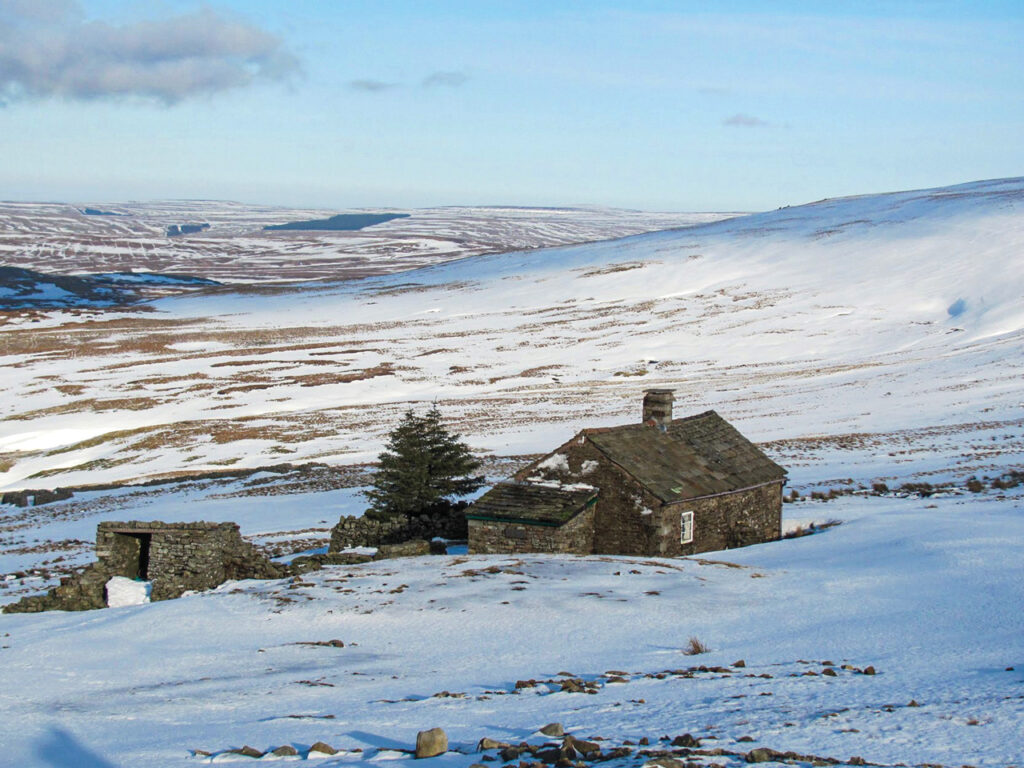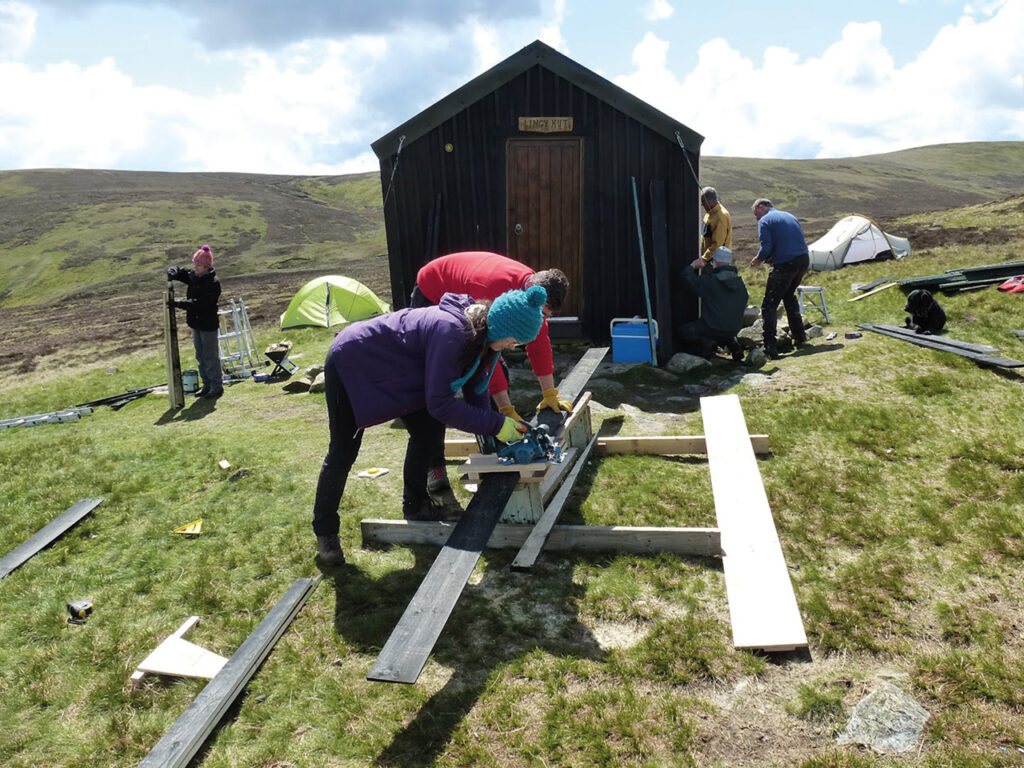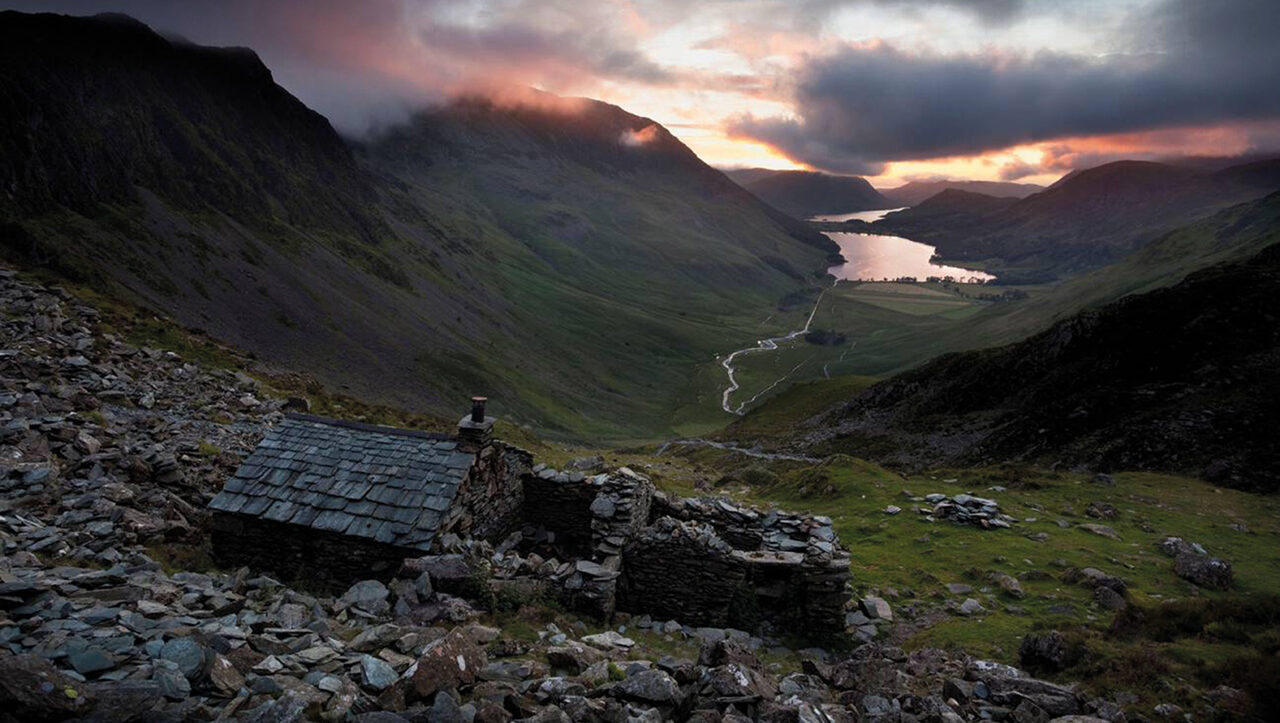Gimme shelter
You won’t find them on Airbnb and you’re lucky if there’s a compost toilet, but those who stay in bothies say it’s an experience unmatched by any other
At the highest point of the Pennines on Cross Fell work is underway to re-roof Greg’s Hut. The stone building was originally a blacksmith’s shop and later housed miners working at the nearby Katelock lead mine. The slopes of Cross Fell produced over 13,000 tonnes of ore between 1811 and 1911 and miners lived in the hut during the week, walking home at weekends. As industry declined the hut was left to the elements.
“You have to have a love for rough travelling and rough country, and of being self-sufficient.”
Popular with walkers as part of the Pennine Way, Cross Fell stands at an impressive 893 metres and in 1968 a group of climbing club friends spotted the potential for the dilapidated hut to provide hard-earned respite to climbers. They rebuilt it from ruin and named it after their friend, John Gregory, who had died tragically in a climbing accident that year. It became England’s first bothy – a simple shelter in remote country for the use and benefit of all who love wild and lonely places.
Although bothies are synonymous with Scotland’s wilderness, the Mountain Bothies Association (MBA) is responsible for 103 bothies and two emergency mountain shelters both north and south of the borders (84 in Scotland, 12 in the North of England and nine in Wales). Those in the North are confined to Northumberland – including Haughton Green in Kielder and Spithope near Byrness – and Cumbria, including Great Lingy in Keswick, Mosedale Cottage near Howes and Warnscale Head in Buttermere.
“The ambience is something that greets you as soon as you lift the latch. You may gaze upon it from a distance, and you approach with expectations. Will you have it to yourself or will you meet fellow travellers and perhaps share tales and a whisky in front of the fire? You never know how your night will be, and that’s part of the appeal,” says Paul Milligan, 48, a keen climber and cyclist from Scotland who’s been bedding down in bothies for the past 30 years.
“My first bothy experience was in the autumn of 1992, at the old Camasunary bothy on the Isle of Skye after our tents had flooded during a nasty storm. We got a fire going, met some fellow mountaineers who’d also had to bail, and a great night was had. I was taken with the concept from the outset, and it was the first of hundreds of nights in bothies,” says Milligan, who’s hesitant to promote any bothy in particular as he believes “too much publicity can be ruinous”.
“Back in the day we learned about new bothies by talking to people by the fireside and it was exciting to find out about a potential next adventure. That was part of the appeal. The unexpected element has been lost in the era of the internet,” says the climber, whose most outstanding visits have been particularly isolated locations.

“Maol Bhuidhe [in the north-west Highlands] and the Tarf Hotel [eastern Highlands] spring to mind. It is several hours of walking or biking to even reach them. Coastal bothies, where you can watch the waves crash on the beach, are also fantastic. Kearvaig near Cape Wrath [northern Highlands] is stunning and Dibidil and Guirdill on the Isle of Rum are both difficult to reach and have that nautical ambience as visitors have adorned the interiors with beachcombing trophies.”
Then Milligan recalls the very high mountain shelters, such as the Hutchison Hut in the Cairngorms. “But one of my favourites is Hermit’s bothy in Sutherland. Sandy, a war veteran, lived there for decades in what was believed to be the last inhabited dwelling in Scotland without electricity or running water. I visited once but he wasn’t in. He eventually left in the late 1990s due to ill health, but I always feel his presence when I stay there.”
Milligan believes the appeal of bothies is wide-ranging. “For some it is simply seeking shelter from the elements but for many it is the experience. The whole concept of an unlocked and free shelter is in itself something of an unusual thing in the 21st century. But I’d advise anyone visiting a bothy to have an open mind. You may have it to yourself or need to share. Sometimes several parties may turn up and musical instruments and whisky can flow, so if you want a guaranteed sleep, take a tent. Also, I’d encourage people to tag lightly when it comes to social media. If places become too busy, they can be ruined and the very tranquillity we seek can be lost.”
The term “bothying” emerged in the second half of the 20th century. Following the Second World War, wages increased, working hours shortened and mountaineering and hill walking became increasingly popular pastimes.
At the same time, hill farming declined, and modern machinery allowed easier access to remote locations, which meant remote farmsteads were deserted.
By the 1960s, these abandoned buildings were commonly used by hillwalkers. One of these hikers was Bernard Heath who was flicking through the visitors book during his stay at Backhill of Bush bothy in Dumfries and Galloway in 1965 when he saw someone had suggested a club be set up to save bothies from deterioration.
By December that year, Heath had founded the MBA. Along with his wife Betty, he dedicated his life to maintaining these buildings for everyone to enjoy until his death earlier this year. Only two bothies are owned by the MBA – the others remain in the ownership of whoever owns the land.
“What we do is look after the buildings on behalf of the owners who want the general public to use them. There are typically one or two requests a year from landowners who ask whether we would be interested in turning a building into an open shelter and looking after it. The only criteria is that it’s not too close to a public road or habitation,” explains Neil Stewart, publicity co-ordinator for the MBA.
“Like Bernard said, bothies are wilderness shelters. That’s what they’ve always been. You have to work to get to a bothy. Although there are a number in Scotland closed due to the deer stalking season, which can run from August to October, or even February, most of them are open all year round, but people can check on the website.”
Stewart’s experience of bothies began in the 1980s when he used them while walking Scotland’s Munros. “It got me interested in bothies and the bothy culture, and the value of bothies. When I retired, I was looking for something to do on a voluntary basis, and the MBA was an obvious choice.”
Although it’s impossible to collate just how many people visit bothies, the number of them has increased steadily over the years, as has curiosity.
“I think there’s a greater interest and understanding in how the outdoors and nature can affect people’s welfare, but the main reason they’ve become more popular is the internet and social media, because more people know about them now than even 10 years ago,” says Stewart.
“There is a problem with people leaving litter and not treating the buildings as they should, but if you look back to the very early days of the MBA and the journals produced then, this has always been a problem. It’s a societal problem, not a bothy problem. There will always be people who don’t treat the outdoors as they should, and that applies to bothies as well.”
That’s why the MBA produced the Bothy Code, which provides simple guidelines for people using them, especially newbies.
“We’ve lost a very few bothies in the past because people have not behaved responsibly. If they’re regularly disused, the owner will wonder why they’re doing it, and close it,” says Stewart.
The MBA is also keen to stress that while the term “bothy” is bandied about by holiday providers to describe charmingly rustic accommodation, the real deal is not a holiday cottage. Instead, visitors are likely to find a sleeping platform, and a compost toilet if they’re lucky. Otherwise, they’ll need to grab a spade.

“Any comforts have to be carried in,” says Stewart. “There have been a few instances where we hear about people turning up for a week to use it as accommodation, but these are open shelters with minimal facilities for a night or two for people who are engaging in hikes in that area. You have to have a love for rough travelling and rough country, and of being self-sufficient.”
Back on Cross Fell, the re-roofing of Greg’s Hut is one of the biggest projects the MBA has undertaken and it remains closed throughout August and September. The logistics of working at its altitude and exposed to the elements means that precise finish dates are not possible to hazard a guess at.
“Greg’s Hut has been subject to awful weather over the years, so there is a major refurbishment underway,” says Stewart. “We want to replace like for like to retain the character of the building, and it needs a specialist firm to carry out the work.
“It’s also at the highest point in the Pennines, so it’s a problem getting material to it. All that increases the costs, so for the first time in our history, we decided to mount a fundraising campaign.”
Typically, the work would be carried out by volunteers, and financed by members of the association who pay the annual £25 membership fee.
One of those members is Phoebe Smith, 35, author, adventurer and host of the Wander Woman podcast from London, who wrote 2015’s The Book of the Bothy.
“In a world where everything is bookable, I just wanted to celebrate the serendipitous nature of bothies. They’ve provided the backdrop to some of my most memorable encounters and some of the happiest adventures. I never set out to catalogue all the bothies as I think that takes away some of the magic of finding one yourself, but I did want to inspire people to try them even just once, which is why I include a vignette of a particular experience I had in each one I feature,” says Smith.
“I’m particularly captivated by the history of Ben Alder Cottage in Central Highlands, which is said to be haunted, the old miner’s bunkhouse in Mosedale, Lake District, which really makes you feel like you’ve stepped back in time, and the former coastguard’s lookout on the Isle of Skye. You can sit at the window and watch for whales – magical.
“But my favourite is always the one I’m sleeping in at the time. It’s more than just the building – it’s the entire experience, from the hills you’ve climbed to get there to the people you meet, or don’t. I’ve spent some wonderful nights with huge bothies just to myself. It’s why my advice to someone who hasn’t stayed in one before is simply, do it. The wilderness brings out the best in people.”
1. Respect other users. Leave the bothy clean and tidy with dry kindling for the next visitors.
2. Respect the bothy. Tell the MBA about any accidental damage, don’t leave graffiti, or vandalise the bothy. Take all rubbish you can’t burn, ensure the fire is out before you leave, and the doors and windows are properly closed.
3. Respect the surroundings. If there’s no toilet, bury human waste out of sight. Use the spade provided, keep well away from the water supply and never use the vicinity of the bothy as a toilet. Never cut live wood or damage estate property.
4. Respect agreement with the estate. Observe any restrictions on use of the bothy, and remember bothies are available for short stays only.
5. Respect restriction on numbers. Groups of six or more should not use a bothy. Bothies are not available for commercial groups.
Source: Mountain Bothies Association

Leave a reply
Your email address will not be published.